A History of the County of Hampshire: Volume 3. Originally published by Victoria County History, London, 1908.
This free content was digitised by double rekeying. All rights reserved.
'Parishes: Preston Candover', in A History of the County of Hampshire: Volume 3, ed. William Page (London, 1908), British History Online https://prod.british-history.ac.uk/vch/hants/vol3/pp371-377 [accessed 23 April 2025].
'Parishes: Preston Candover', in A History of the County of Hampshire: Volume 3. Edited by William Page (London, 1908), British History Online, accessed April 23, 2025, https://prod.british-history.ac.uk/vch/hants/vol3/pp371-377.
"Parishes: Preston Candover". A History of the County of Hampshire: Volume 3. Ed. William Page (London, 1908), British History Online. Web. 23 April 2025. https://prod.british-history.ac.uk/vch/hants/vol3/pp371-377.
In this section
PRESTON CANDOVER
Candevre, Candovre (xi cent.); Candeura, Candieura (xii cent.); Preste Candevere, Kandever, Kandevera (xiii cent.); Preston Candeuere (xiv cent.); Preston in Candeveresdene (xv cent.); Kandavor (xvii cent.).
The parish of Preston Candover, containing 3,457 acres, lies on comparatively low ground, south of the high country round Farleigh Wallop and Nutley, and north-west of that which rises to Wield and beyond Wield to Medsted. The ground rises generally from west to east, the greatest height, 500 ft. above the ordnance datum, being reached in the north-east near Moundsmere Farm.
The village itself lies on the lowest ground towards the west of the parish on the road which comes northeast from Northington and the two other Candovers, and runs across the parish to enter Nutley at Axford and continues uphill to Farleigh and thence to Basingstoke. As the road enters the village the farm buildings of Lower Farm lie on the east, as a branch road turns off south-east towards Godsfield and Alresford. On the west at the corner of a lane which runs north-west by the Manor Farm to Preston Copse, is the old vicarage, now a private house, north of which is the graveyard and the remains of the old church of St. Mary, now used as a mortuary chapel. As the road continues up the village, South Hall, the property and residence of Mr. C. Hall, stands back on the east, while on the west is North Hall, the manor-house of the Purefoy estate, now the property and residence of Mr. C. L. Wade.
Passing by several good cottages and houses the road comes to the modern church of St. Mary, to which, as it stands well to the east, a lychgate leads the way over a grass inclosure. Here the road curves to the north by the 'Purefoy Arms,' which stands on the west almost opposite the church, and passing by the several shops and cottages of the village, one of which on the east side serves as the post office, goes on to the schools, which stand in their inclosed playground also on the east side of the road. On high ground north-east of the schools is the modern vicarage standing in good grounds. Beyond the schools two or three thatched cottages lie east and west of the road, and a small plain tiled building, a Primitive Methodist chapel, bearing the date 1863, stands on the east. Passing on through the north end of the village, the wooden fence inclosing the well-wooded grounds of the west park of Preston House, the seat of Mrs. Hope, runs along the west side of the road, a drive at the further end leading up to the house. On the opposite side of the road are two or three thatched cottages, while from here a road branches east to Bradley and Herriard. Leaving the grounds of Preston House the main road continues north to Axford and so out of the parish.
Moundsmere Farm, lying on the downs in the north-east, is the most interesting spot in the parish. When the property of Southwick Priory, including the manor of Moundsmere, passed to Winchester College by exchange with Henry VIII in 1543, the farmstead was in the very next year used as a sick-house for the Winchester scholars who were stricken down by the plague that visited Winchester in 1544. Thus new buildings appear to have been run up round the farm-house during that year, and a number of scholars were sent there both in the autumn and winter terms. (fn. 1) In 1554, on the occasion of another outbreak of the plague, scholars were again sent to Moundsmere, and, probably by means of a certain sum over from Queen Mary's largess given on her bridal visit to the college, 'the chyldren's hows at Mouseberie (sic) for their comfort in tyme of siknes' was repaired and the barn was fitted with bed-places and windows for their reception. (fn. 2) Mr. Kirby, in his Annals of Winchester College, (fn. 3) quotes an interesting clause inserted after this date in all successive leases of the demesne land of the manor, reserving to the college 'the new buildings adjoining the manor house' with all new rooms that might hereafter be built for such time only as the warden, scholars, schoolmasters, clerks, or servants of the college should 'resort, come, and remain there for the avoiding of the plague or any such pestilential sickness.' But although the tenant of Moundsmere Farm was thus obliged to receive sick scholars at any time, when the plague of 1666 made its appearance in Winchester the sick scholars instead of being sent to Moundsmere were sent to a farm-house at Cranley, and presumably from that time the tenant of Moundsmere escaped his obligation. (fn. 4)
Cobbett, in his Rural Rides, (fn. 5) mentions the avenue of yew trees which runs east of the road south of the village at Preston Candover, estimating it as probably a mile long, 'each containing as nearly as I can guess from twelve to twenty feet of timber.' Chalk, as he says, is the favourite soil of the yew tree, and chalk composes both the soil and subsoil of Preston Candover. Thus on the 2,498¼ acres of arable land the usual crops of wheat, turnips, and oats are grown. Preston Down in the south-east of the parish, with the downs in the north round Moundsmere, make up the greater part of the 985 acres of permanent grass.
There are numerous small copses in the west of the parish—Lilley's Copse and Preston Copse with the small Upper Barn Copse and Furze Yard Copse, and these with Inham Copse near Axford and the large stretch of woodland known as Preston Oak Hills Wood which fills up the north-east corner of the parish, make up the 405¾ acres of woodland included in Preston Candover.
MANORS
In PRESTON CANDOVER at the date of the Domesday Survey there were six separate estates, five of which were owned by the Conqueror's followers who had replaced the Saxon owners, whilst the sixth was still held by a Saxon priest, the pre-Conquest owner. Of these estates William Mauduit had one which in the Confessor's time had been held as two manors; Ralf de Mortimer and his under-tenant Oidelard held the second which had before belonged to Cheping; Hugh de Port, whose under-tenant was Anschitel, held the third which had been a portion of the possessions of Earl Godwin; clerks, or priests, had the fourth which had been the land of Alvric; Cheping had the fifth which was before held by Sberne of Queen Edith; and lastly, Edwin the priest held the sixth of King William as he had held it of King Edward. (fn. 6)
No connexion can be made out between these separate owners and the overlords or owners of the various manors found later in the parish, and any attempt to discover one must be conjectural, except in the case of the lands of William Mauduit which by the twelfth century were in the hands of Robert de Pont de l'Arche, (fn. 7) and in the case of the Mortimer possessions, which remained to that family, Roger de Mortimer and his son Edmund holding in Candover before 1398 and 1424 a fee worth 100s. (fn. 8)
Upon the Pipe Roll of 1166 an assessment for CANDOVER SCOTLAND was given as half a mark. (fn. 9) This was evidently the manor that, in the thirteenth century, Jordan and William Eschotland held. (fn. 10) No further trace of the Eschotland family or their manor can be found unless it can be identified with the manor of Preston Candover, which appears for the first time in the reign of Edward III held by the Hoyvilles.
In 1368 John de Hoyville, son and heir of William de Hoyville, granted to William de Wykeham, bishop of Winchester, the manor of PRESTON CANDOVER and lands in 'Candeveresden.' (fn. 11) In the reign of Richard II the bishop granted this manor to Thomas Warenner and his wife Joan. (fn. 12) The only child of Thomas Warenner and Joan was Agnes, to whose husband, Sir Walter Sandys, the manor descended in the reign of Henry IV. (fn. 13)
The manor remained in the Sandys family (fn. 14) until some time in the latter part of the sixteenth or early part of the seventeenth century, when it seems to have been alienated to a man of the name of Guye, since in 1636 James Guye, yeoman of Preston Candover, sold for £1,110 the manor of Preston Candover with all manorial rights to George Long. (fn. 15)
The new owner, a stout adherent of the Parliament, lived in London during the Civil War, and assisted the Parliament with money. (fn. 16) When he returned home after Basing House had fallen, he found his house a ruin and his land wasted. By way of compensation the Parliament gave him a small farm in Preston Candover from the forfeited property of a recusant, Francis Perkins, the owner of another manor in Preston Candover. (fn. 17) Later, however, Mr. Perkins offering a larger amount than that paid by Mr. Long, was allowed by the Parliamentary Committee to buy back the estate for his son. Against this decision George Long petitioned in vain. (fn. 18)
The Longs, however, recovered their property later, and either this George Long or a son of the same name sold the manor in 1677 to William Soper, (fn. 19) in whose family it remained until the reign of George II, when, in 1739, Patience Soper, one of three daughters, (fn. 20) and evidently heiress of John Soper, of Preston Candover, brought the manor to her husband, William Guidott. (fn. 21) William Guidott, the famous builder of Preston House, died in 1745, and on the death of Patience in 1749 Preston Candover passed to their kinsman and heir William Woodroffe, who took the name of Guidott. (fn. 22)
In 1783 William Woodroffe Guidott sold the estate for £9,000 to John Blackburne, a merchant of London, and John Slade, in equal shares, and in 1789 John Blackburne bought Slade's moiety. (fn. 23) By his will dated 1792 he left his manor and lands to his son John. (fn. 24) He died in debt, and in 1829 an order was made for the sale of his estate to defray his liabilities. (fn. 25) Mr. Rumbold purchased the manor and sold it later to H. King, who was succeeded by his son J. H. King. The latter sold the estate in 1877 to Lord Templemore, from whom it was purchased by Mr. H. J. Hope at the end of the nineteenth century. (fn. 26) Mr. Hope died in 1905; his widow Mrs. Hope is now lady of the manor.
The earliest reference to the manor of STEVENBURY or HORWOODS is apparently on a Pipe Roll of 1166 when the name of 'Candeura Stephani' appears. (fn. 27) Probably from this Stephen, who owned Candover, the manor known in the thirteenth century as 'la Stevenbury' took its name. Robert de Watteville, lord of the manor of la Stevenbury in the thirteenth century, granted a chantry therein to the priory of Southwick. (fn. 28) Nothing more is known of this manor until the name of Horwoods occurs in connexion with it in the reign of Edward II, when Thomas de Cailly held rent in Preston Candover which he received from William de Horwode, (fn. 29) who held the manor of Stevenbury or Horwoods as member of the manor of Bradfield in Berkshire, first of the De Somerys and then of the Langfords and the Staffords, lords of Bradfield. (fn. 30)
In 1322 the same William de Horwood held this manor, which consisted of 2 carucates of land, (fn. 31) and died seised of it in 1349. (fn. 32) His son Thomas had died in the king's service at Calais two years before, and he left, as heir, his grandson, also named William, aged seven. (fn. 33) The manor variously called Stevenbury or Preston Candover manor remained in the Horwood family, the holders in tail male from 1422 being William Horwood, who left a son William, (fn. 34) and John Horwood and his wife Katherine, (fn. 35) whose son John married Elizabeth, and died in the reign of Edward IV. (fn. 36) The last John Horwood left a daughter Alianora, as heiress, but a posthumous son was born who became heir. (fn. 37) He, however, died while still a minor in 1495, when the manor of Preston Candover went to his uncle Hugh Horwood. (fn. 38) The last of the male line of Horwood died five years later, leaving as his heirs his four sisters, Joan wife of Richard Savage, Katherine wife of John Frith, Alice wife of Thomas Lende, and Christine wife of Ingilram Prior. (fn. 39) Of these Alice Lende and Catherine Frith (then Catherine Peter by her second marriage) died in the reign of Henry VIII each seised of a third part of the manor of Horwood in Preston Candover. (fn. 40) Another third part appears to have been sold by John Prior to Richard More in the reign of Philip and Mary, (fn. 41) and Sir William and Lady Elizabeth Warham in Elizabeth's reign held a fifth part of Horwoods manor. Dame Elizabeth Warham had evidently been previously married to More, by whom the scattered portions of Horwoods manor must have been acquired. (fn. 42) From her and Richard More her son Horwoods alias 'Stoniburie' manor passed by sale to Thomas Dabridgecourt of Stratfield Saye (fn. 43) in Elizabeth's reign, and was held by this well-known family until 1634 when Thomas Dabridgecourt and Barbara his wife seem to have sold it to Sir Richard Harrison. (fn. 44) John Harrison (fn. 45) appears as owner of Horwoods manor in 1669, and about a year later it seems to have been transferred to Anthony Guidott by Anne Harrison, widow of Richard Harrison. (fn. 46) With the Guidott family, who already owned the manor of Preston House in this parish, Horwoods remained, forming part of William Woodroffe Guidott's property in 1772; (fn. 47) thence onwards it has followed the descent of Preston House manor with which it is now incorporated. (fn. 48)
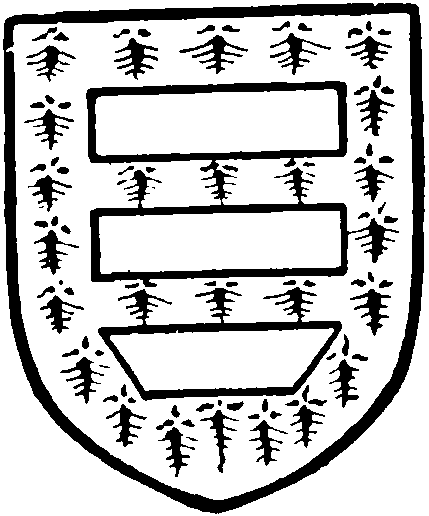
Dabridgecourt. Ermine three bars gules cut off at the ends.
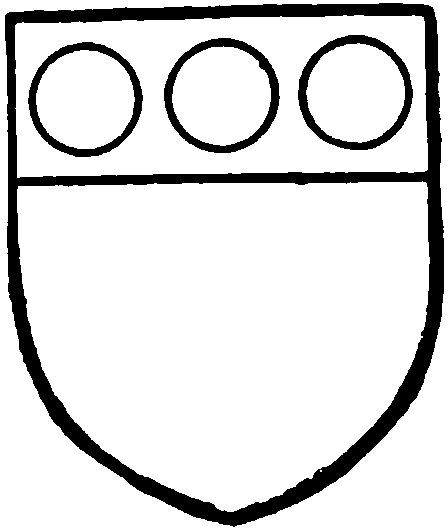
Camoys. Argent a chief gules with three roundels argent.
The overlordship of the property afterwards known as the manor of BOTILLERS CANDOVER belonged during the fifteenth century to the family of Camoys, Botillers Candover being held of Lady Joan de Camoys and her heirs. (fn. 49)
Early in the thirteenth century Robert the Butler or Pincerna was settled (fn. 50) in Candover, and later in the same century and the next there is evidence of ownership by the family now known as Botteleye (fn. 51) and Botiller. (fn. 52) In 1310 William le Botiller and Alice his wife held eleven messuages, 2 carucates of land, 20 acres of wood, and 30s. rent in Preston Candover, (fn. 53) their heirs being their children, John, William, Robert, and Elizabeth, (fn. 54) from one of whom probably the land passed to John de Kacchefrensh and Alice his wife, since they, in 1345, held eleven messuages, 2 carucates of land, 40 acres of wood, and 30s. rent in Preston Candover. (fn. 55) John de Kacchefrensh settled the reversion of his property upon Oliver de Bohun and Margaret his wife during their lives, with final remainder to John de Warbelton and Alice his wife. (fn. 56) Accordingly in 1368 John de Warbelton held lands called 'terra de Boteller in Candeveresden,' in reversion, he being the son of Alice then widow of John de Warbelton. (fn. 57) Katherine wife of the younger John de Warbelton died, in 1404, seised of a house and carucate of land in Preston Candover, (fn. 58) and her son William, (fn. 59) in 1405, held a manor 'called Botillers in Preston in Candeveresden.' (fn. 60) William Warbelton, who died 11 October, 1469, held the manor of 'Botelers Candevere,' and having no issue left this land to William Skulle the son of his cousin Agnes. (fn. 61)
In 1485 William Skulle apparently held the manor. (fn. 62) Here the history of Botillers Candover ceases, unless it can be identified with the manor called Purefoys.
In the June of 1495 Richard More died in possession of Preston Candover manor known later as PUREFOYS. (fn. 63) It is difficult to determine his title to this property unless it was conveyed to him by William Skulle, or unless some land in Preston Candover passed to the Mores from the Horwoods. (fn. 64)
The manor of Richard More, however, was not held either of the Camoys family, or of the lords of Bradfield, as was Horwoods manor, but of Lord St. John. (fn. 65) Katherine, Richard More's widow, held the manor for life under her late husband's will, with remainder to her son John More, then aged twenty, (fn. 66) or in default of male heirs, the property, according to the settlement, was to remain to Isabel Williams, wife of John Williams, among several other heirs. (fn. 67)
There is no mention of John More being in possession of Preston Candover, but the property seems to have descended or been conveyed to Isabel Williams. (fn. 68)
Her son, Reginald Williams, next held the property, whose son John, dying without issue, was succeeded by his brother Nicholas. (fn. 69)
The title of Nicholas to the estate was disputed in Elizabeth's reign by Walter Mayhew, a husbandman of Rotherwick, who claimed the manor in right of his wife Elizabeth, who, according to Walter Mayhew's statement, was a daughter of John More, son of that Richard More who had died in 1495 seised of the manor of Preston Candover.
The defendant traced his title to his grandmother, Dame Isabel Williams. (fn. 70) The matter was, about 1566, referred to the arbitration of the bishop of Winchester and Henry Wallop, (fn. 71) and evidently Nicholas Williams won his case, as Walter Mayhew in 1579 relinquished his claim to Francis Perkins, (fn. 72) who by marriage with a daughter of Nicholas Williams (fn. 73) had become lord of the manor. (fn. 74) He died in 1617, (fn. 75) and his son, a Roman Catholic Royalist, in his old age suffered sequestration of his estate for recusancy under the Commonwealth. (fn. 76) The family held the manor until 1733, when the fourth Francis Perkins, of Preston Candover, (fn. 77) who had married the famous Arabella Fermor, (fn. 78) sold it to Thomas Hall for £1,700. (fn. 79) Elizabeth granddaughter of Thomas Hall, heiress of her brother, brought the manor to George Purefoy Jervoise, (fn. 80) who bequeathed it to his niece, Elizabeth Fitzgerald, from whose grandson, Captain Richard Purefoy Purefoy, it was purchased in 1905 by Mr. J. C. A. Hall and Mr. C. Wade, (fn. 81) the present owners.
Of William de Pont de l'Arche, in 1381, the priory of Southwick held the manor later known as MOUNDSMERE. (fn. 82)
In the year 1290 the prior of Southwick's manor of Candover was valued at £3 11s. 7d. (fn. 83) In the thirteenth century Robert de Pont de l'Arche confirmed the grant of his father of the church with the manor of Candover (which comprised five hides of land with wood and meadow) to the canons of Portchester, (fn. 84) and this grant was again confirmed by Henry III, Edward II, and Richard II. (fn. 85)
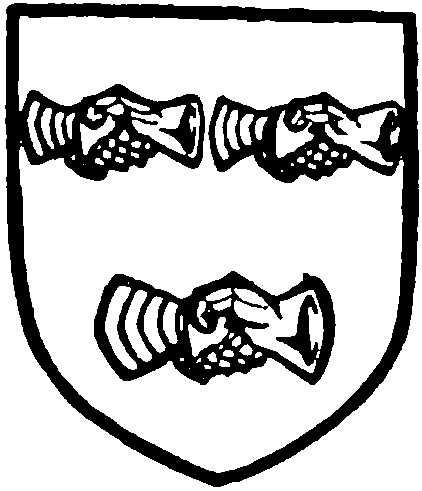
Purefoy. Sable three pairs of clasped hands in armour argent.
The land held by the priory in this parish was increased by grants from other early benefactors—Jordan and William Eschotland—who gave to the prior and canons the chapel, with the tithes, belonging to their manor of Candover, together with some tenements for the support of the chapel. (fn. 86) Another donor appears in Walter de Passeflamberd, who gave a virgate in Candover 'of the fee of la Stavenburie.' (fn. 87) Thomas Dounton also granted land in the thirteenth century to the priory. (fn. 88) In 1316 and 1322 the prior of Southwick was described as lord of Preston Candover, (fn. 89) and the ninths due to the priory in the parish were, in 1339, of the value of 26s. (fn. 90) In the reign of Henry IV the prior recovered 100s. as damages from a neighbouring lord of the manor, William Horwood, who had impounded 300 sheep belonging to the priory, of which forty had since died of hunger. (fn. 91)
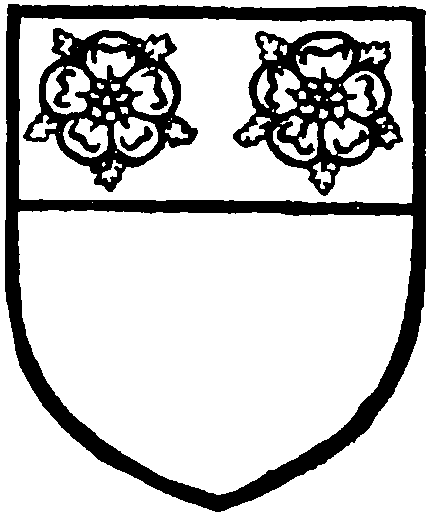
Southwick Priory. Argent a chief sable with two roses argent.
At the time of the Dissolution the property of the priory was known as the manor of Moundsmere. (fn. 92) It afterwards formed part of the dower of Anne of Cleves (fn. 93) and Catherine Howard, (fn. 94) and on the death of the latter Henry VIII granted the manor of Moundsmere, in part exchange for the manor of Harmondsworth and others, to the college of St. Mary, Winchester. (fn. 95) With the college it long remained, and was used for a hospital in the times of plague. (fn. 96) In 1906 Moundsmere was sold by the college to Mr. Wilfrid Buckley, who is the present owner.
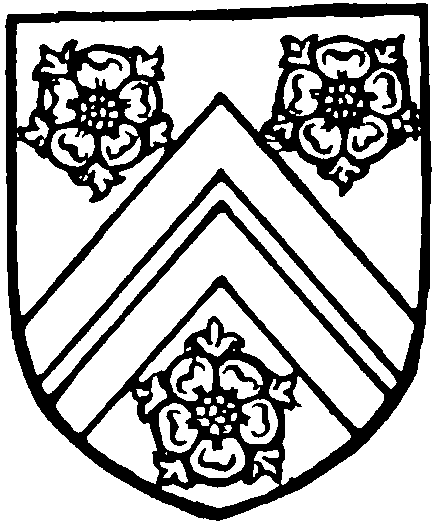
Winchester College. Argent two cheverons sable between three roses gules.
The crown held a rent from Moundsmere which was granted by James I to his queen, Anne, (fn. 97) and by Charles II to Lord Hawley and others in trust for John Lindsay, who had undertaken to defray £25,384 2s. 1d. due from the crown to London city. (fn. 98) A fine between Sarah Rolle and William Parker respecting the same rent occurs in the reign of George I. (fn. 99)
The name of Oades occurs frequently in the records of Moundsmere, where that family owned land in the seventeenth and eighteenth centuries. (fn. 100) In 1639 an order was made against one James Oades of Preston Candover since he had in August, 1637, 'rhymed profanely on the Lord's prayer,' and had been accused of blaspheming the Scriptures. His punishment was a public submission in his parish church and in Winchester Cathedral, and a fine of £100. (fn. 101)
The family of Inkepenne held land in Preston Candover of the Knights Hospitallers. (fn. 102) John de Inkepenne held land there in the fourteenth century. (fn. 103) Owing to the minority of his heir, who died in wardship, the house and the carucate of land held of the bishop of Winchester and his four virgates held of the Knights Hospitallers came into the royal hands (fn. 104) until the majority of his other son Robert. Robert Inkepenne and his son Robert died seised of land in Candover in 1405 and 1406. (fn. 105) The name of Richard son of Robert Inkepenne occurs in 1407; (fn. 106) in 1410 Robert Inkepenne died seised of land in Preston Candover, (fn. 107) which in 1440 another Robert Inkepenne held. (fn. 108) In 1510 John Inkepenne held land (fn. 109) of Katherine More. (fn. 110) The name of William Inkepenne occurs in 1518. (fn. 111)
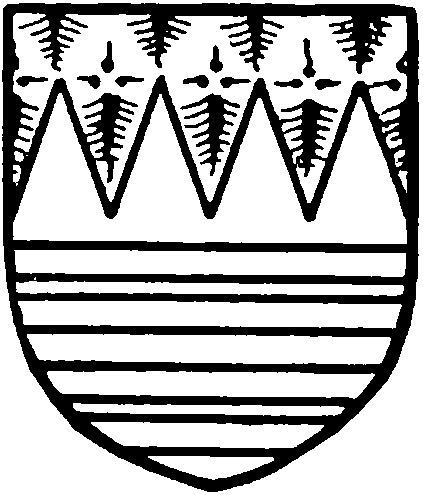
Inkepenne. Gules two gimel bars or and a chief indented ermine.
The name of CANTERTON often appears in the church rate-book. (fn. 112) In the reign of Charles I Sir Richard Norton leased a tenement called Canterton in Preston Candover to Edward Elkins, husbandman, (fn. 113) for £10 yearly rent. Canterton is now included in Preston House estate. (fn. 114)
For several centuries a small portion of land in Preston Candover followed the fortunes of the manor of Woodcott. (fn. 115) It was evidently included in the two and a half virgates held by Miles the Porter in Bermondspit Hundred at the time of the Survey. (fn. 116) With Woodcott a hide of land in Candover was granted to Matthew de Wallop for the service of keeping the king's gaol at Winchester and mewing the royal hawks. (fn. 117) The lords of Woodcott and warders of Winchester gaol held this land worth 11s. in Candover, (fn. 118) from the thirteenth until the sixteenth century; Warin son of Geoffrey held it in 1227, (fn. 119) and it is last mentioned in the reign of Charles I, (fn. 120) when it was held by Anthony Bruning.
CHURCH
Of the old church of OUR LADY the chancel only remains, though the limits of the old nave are preserved by blocks of stone marking the position of its western angles. It was burnt down in 1883, a new church being built in the middle of the village to take its place. It had no aisles, but on the north side an eighteenth-century building which contained the pew of the Guidott family, and on the west gable of the nave was a wooden bell-turret.
The chancel dates from c. 1190, having a north window of that date, a small pointed light with a wide internal splay and semicircular rear-arch. The east window is of doubtful date, a wide single light which was probably divided into two by tracery, which is now lost. In the south wall is a blocked doorway, built of old material re-used, and a square-headed window of two trefoiled lights, of late fifteenth-century date. The west wall is modern, there having been no chancel arch in the old church, and in it is a round-headed doorway, also made up of old material, some of it of twelfth-century date. On the gable above it is a wooden bell-cote with a small modern bell. In the floor is a slab with the brass of Katherine Dabridgecourt, 1607, the figure, inscription plate, and one shield of arms being preserved. The new church is built of red brick and stone, and has a chancel with north vestries, nave with north aisle, and a tower and spire at the north-west. No part of the old church has been worked into the new building, and the font, though brought thence, is modern.
In the churchyard is a sundial made up of a twelfth-century capital and base, both being set upside down.
In the tower are five modern bells. In the old church there were at one time four bells, two of which were recast by Warner in 1870. The two others were recast by Warner and a fifth added in 1885, when they were moved to the new church.
The plate consists of a cup and paten of 1746, a jug-shaped flagon of 1885, and an almsdish of 1798, with the initials E.H. in the centre, probably for Elizabeth Hall, who owned land in the parish and died about 1798. (fn. 121)
The registers are in a somewhat fragmentary condition. The earliest entries are on a parchment recovered from Basingstoke church, and record the marriages from 1584 to 1695; the second portion contains the baptisms, marriages, and burials from 1724 to 1736, and the third is a book containing the baptisms for Preston Candover and Nutley, 1688– 1812, marriages 1696–1754, and burials 1724–1812. The printed marriage register, 1755–1812, is also preserved.
ADVOWSON
Although Domesday makes no mention of a church in Preston Candover, there seem to have been two churches besides manorial chapels in the thirteenth century. Richard de Candevere, 'Filius Wys,' granted in that century the advowson of the church of Preston Candover to the priory of Southwick, (fn. 122) and John 'de Bottel' likewise granted the advowson of a church in the same place to Matthew, prior of Southwick, in 1255. (fn. 123) The grant of his manor by Robert or William de Pont de l'Arche included a church; (fn. 124) Jordan Eschotland also granted the chapel belonging to his manor, (fn. 125) and the priory moreover held a chantry in the manorial chapel of Stevenbury. (fn. 126) The control of ecclesiastical matters in Preston Candover was therefore vested in the priors from early times, and they held sole patronage (fn. 127) until the Dissolution, when the advowson was given to the dean and chapter of Winchester, (fn. 128) who ever since have held it. (fn. 129)
A church that was not under the patronage of the priory is mentioned once only, when in 1322 there was said to be a parish church in the manor of William de Horwood of the advowson of John de Somery and worth 25 marks. There is no other reference, however, to this church. (fn. 130)
The only mention of a chantry in Preston Candover occurs in the account of a quarrel between Matthew prior of Southwick and Robert de Watteville concerning a virgate of land, tithes, and a chantry in the chapel in Robert's court in 'la Stevenburie,' (fn. 131) with the result that the virgate (fn. 132) and tithes were assured to the priory. The chantry, too, was granted to the priory, with the proviso that its priest must render fealty to the rector of the mother church of Preston Candover, and that the services, which were to be celebrated three times weekly when the lord of the manor was present, were only to be attended by the family of 'la Stevenburie' and not by the parishioners of the church of Preston Candover.
CHARITIES
Robert Lipscomb, by will, 1711, gave a rent-charge of £4 per annum to the poor of this parish. The charge was upon leasehold property, and upon the determination of the lease the charity lapsed.
An unknown donor, as stated in the returns made to Parliament in 1786, gave lands to the poor, producing 10s. a year, and the same returns state that a sum of £5 was given by some person unknown, producing 5s. a year. In 1904 the sum of 15s. was paid by Cecil Wade, esq., out of the North Hall estate, and given to six recipients.
Thomas Hall, by will proved in the P.C.C. in 1784, founded a school and endowed it with 7 acres of land in this parish. (fn. 133)
Church lands.
Upon the inclosure of the common fields in this parish 11 a. 2 r. 27 p. were awarded in lieu of certain parcels of land formerly held by the churchwardens. The land is let at £15 a year, which is paid to the churchwardens' account.
In 1870 30 acres of land were awarded as a poor's allotment, subject to a yearly rent-charge of £5 payable to the overseers. The land is in the hands of the parish council. In 1905–6 £5 was received for letting the sporting and shooting, and £3 15s. from the sale of the underwood.